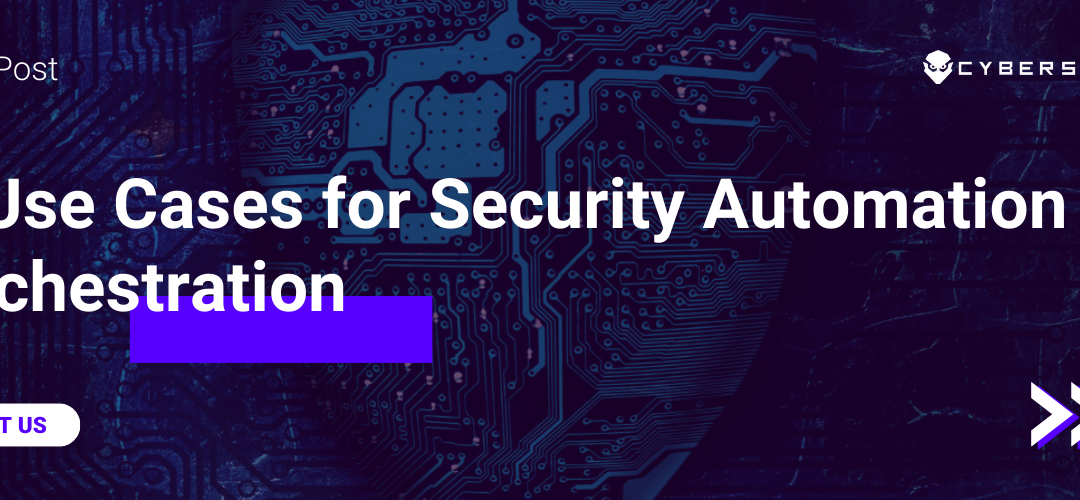As businesses become more digitized and automated, the need for security automation and orchestration increases. Security automation tools can help fortify your security posture by automating routine tasks.
Today, security automation and orchestration (SAO) is considered a must-have for any organization looking to improve its cybersecurity posture. While there are many different SAO tools and platforms on the market, each has its benefits and drawbacks.
So, what’s the best way to choose the right tool for your organization? This blog post will look at three common use cases for SAO and how they can help address them. Read on to learn more!
What Is Security Automation?
Security automation is using technology to automate security-related procedures and tasks. The automation can include everything from identity and access management to vulnerability management and incident response. Security automation can be a powerful tool for enhancing an organization’s overall security posture when appropriately implemented.
Organizations can improve their security posture by automating these tasks while freeing up limited resources. Security automation is often used with other security technologies, such as firewalls and intrusion detection systems.
These tools can provide a comprehensive solution for protecting data and assets when used together. In addition, security automation can help to speed up incident response times and reduce the overall cost of managing security.
As the need for comprehensive security solutions grows, security automation will become an increasingly important part of the IT landscape. However, there are some potential drawbacks to consider as well. For example, if not configured correctly, automated tools can generate many false positives, which can overwhelm already overstretched security teams.
What Is Security Orchestration?
Security orchestration automates the coordination of incident response processes and procedures across security tools and team members. By automating repetitive tasks, such as data collection and communication, security orchestration frees up security analysts to focus on more strategic tasks, such as investigating and responding to incidents.
Security orchestration also enables analysts to leverage the collective insights of the security team by providing a centralized view of all security incidents. By integrating with multiple security tools, security orchestration can provide a comprehensive picture of an organization’s security posture, enabling analysts to identify and respond to threats more effectively. In sum, security orchestration is a powerful tool for improving incident response efficiency and effectiveness.
Use Cases for Security Automation & Orchestration
1. Vulnerability Management
Security automation and orchestration (SA&O) can help vulnerability management in several ways. First, SA&O can automate identifying vulnerabilities and potential exploits by monitoring devices and gathering data from multiple sources.
You can analyze this data to identify patterns that may indicate a vulnerability. Second, SA&O can automate patching or mitigating vulnerabilities by deploying the appropriate security controls to devices in a coordinated manner. This automation can help to ensure that vulnerabilities are patched quickly and mitigations are put in place before exploits are developed.
Finally, SA&O can automate the process of responding to incidents by coordinating the actions of multiple security devices and systems. This prompt action can help to ensure that incidents are contained and remediated quickly.
There are many benefits to using SA&O in vulnerability management, including:
Increased Efficiency: Automated tasks take less time to complete, which frees up your team’s time to focus on more important work.
Improved Accuracy: Tasks performed automatically are less likely to contain errors than manual tasks.
Greater Visibility: Automated processes provide greater visibility into your organization’s security posture.
Enhanced Collaboration: SA&O can help team members collaborate more effectively by sharing information and coordinating activities in real-time
2. Endpoint Protection
Security Automation & Orchestration can help in Endpoint Protection in a few ways. First, it helps to speed up the process of identifying and responding to threats. The time taken to identify is vital because the faster threats can be identified and addressed, the less damage they can do.
Security Automation & Orchestration can help ensure that all aspects of endpoint protection work together effectively. Security Automation & Orchestration may assist in ensuring that no stone is left unturned when it comes to safeguarding your devices by automating the coordination between different security tools.
Lastly, Security Automation & Orchestration can also help to improve compliance by making it easier to track and report on security incidents. This approach can be critical in regulated industries where compliance is necessary.
3. Threat Hunting
Threat hunting is the proactive process of identifying potential threats that have evaded detection by traditional security solutions. Security automation and orchestration (SA&O) can play a critical role in threat hunting by providing analysts with the ability to automate repetitive tasks, reduce investigation times, and improve incident response.
SA&O platforms provide a centralized view of an organization’s security posture and can help analysts identify potential threats that have gone undetected. By automating repetitive tasks, SA&O platforms can free up time for analysts to focus on more complex investigations. In addition, SA&O platforms can improve incident response times by providing a coordinated view of an organization’s security posture.
Security automation and orchestration can help analysts identify potential threats that have gone undetected. By automating repetitive tasks, SA&O platforms can free up time for analysts to focus on more complex investigations. In addition, SA&O platforms can improve incident response times by providing a coordinated view of an organization’s security posture.
How Security Automation & Orchestration Can Help Strengthen Your Cybersecurity Defenses
Security automation and orchestration can help make this possible by providing a way to automate and streamline many of the manual tasks involved in cybersecurity.
When it comes to security automation, it can use several different tools and technologies. For example, security information and event management (SIEM) systems can help to collect and aggregate data from multiple sources for analysis. Additionally, you can use intrusion detection and prevention systems (IDPS) to detect and block malicious activity.
Organizations can also use security orchestration to automate many tasks in response to a security incident. For example, an organization could use security orchestration to deploy countermeasures to thwart an ongoing attack automatically. Additionally, security orchestration can automate the steps involved in investigating and responding to a security incident.
Using Our Unrivaled Security Services, You Can Feel Secure!
If you’re interested in learning more about how we can help you secure your business, schedule a free consultation with us today. We’ll review your specific needs and tailor a security plan right for you.
In addition to our comprehensive security services, we also offer a wide range of other IT services, virtual Cisco services, vulnerability protection, laptop, email security, cloud services, and more. So if you’re looking for a one-stop-shop for all your IT needs, look no further than Cyber Sainik.




